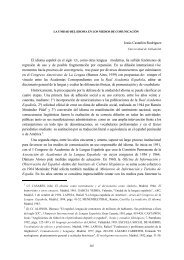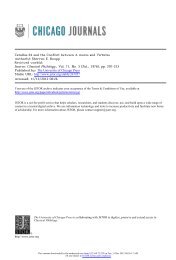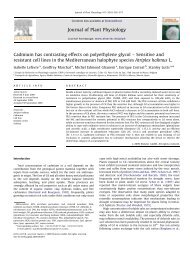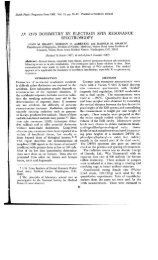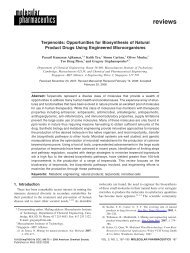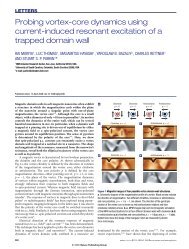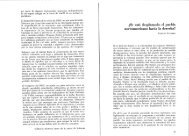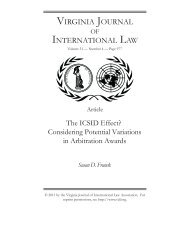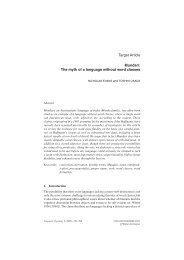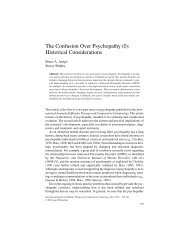Volatile composition of oak and chestnut woods used in brandy ...
Volatile composition of oak and chestnut woods used in brandy ...
Volatile composition of oak and chestnut woods used in brandy ...
Create successful ePaper yourself
Turn your PDF publications into a flip-book with our unique Google optimized e-Paper software.
(Chatonnet & Dubourdieu, 1998; Masson et al., 1995).<br />
In the analysis <strong>of</strong> all the different types <strong>of</strong> wood (Table 2),<br />
we found a similar wood discrim<strong>in</strong>ation based on<br />
the contents <strong>of</strong> cis-b-methyl-c-octalactone + 4-methylguaiacol.<br />
Concern<strong>in</strong>g hexanoic acid, the variance analysis (Table<br />
1) showed two different groups <strong>of</strong> wood, one constituted<br />
by CFL, CNE, CAST <strong>and</strong> CNG with the lowest<br />
contents <strong>and</strong> other formed by CNF, CFA <strong>and</strong> CAM<br />
with higher content. Others authors also found this acid<br />
<strong>in</strong> untoasted <strong>oak</strong> extracts (Boidron et al., 1988; Clímaco<br />
& Borralho, 1996) <strong>and</strong> <strong>chestnut</strong> extracts (Clímaco &<br />
Borralho, 1996). Similar wood discrim<strong>in</strong>ation could be<br />
found <strong>in</strong> the ANOVA, concern<strong>in</strong>g all the different types<br />
<strong>of</strong> wood (Table 2).<br />
Based on the eugenol amounts, three homogeneous<br />
groups can be observed, by order<strong>in</strong>g them from the<br />
poorest to the richest: CAST = CNE = CFL = CNG =<br />
CFA < CNF < CAM. These results are similar to those<br />
obta<strong>in</strong>ed by Pérez-Coello et al. (1999), but quite different<br />
from the results observed by other authors (Chatonnet<br />
& Dubourdieu, 1998; Doussot, Pardon, Dedier, &<br />
De Jeso, 2000). The results obta<strong>in</strong>ed from the analysis<br />
<strong>of</strong> all the different wood types are different, they confirm<br />
that CAM is the richest wood <strong>in</strong> this compound, CFA is<br />
a poorest wood <strong>and</strong> CNF is the richest, among the<br />
Portuguese <strong>woods</strong>.<br />
For both analyses (Tables 1 <strong>and</strong> 2), wood orig<strong>in</strong> effect<br />
on the levels <strong>of</strong> 5-methyl-furfural, octanoic acid, decanoic<br />
acid, dodecanoic acid, syr<strong>in</strong>gol <strong>and</strong> 4-allyl-syr<strong>in</strong>gol<br />
was not detected.<br />
Accord<strong>in</strong>g to the results obta<strong>in</strong>ed, we have chosen the<br />
compounds significantly affected by the wood orig<strong>in</strong>, <strong>and</strong><br />
we have submitted these variables to a multidimensional<br />
analysis (cluster<strong>in</strong>g <strong>and</strong> pr<strong>in</strong>cipal component analysis).<br />
Fig. 2 presents the phenogram <strong>of</strong> distances for the<br />
unheated wood types, which presented a cophonetic<br />
1.67<br />
1.25<br />
0.83<br />
Distance<br />
0.42<br />
CNE1<br />
CNE2<br />
CNG1<br />
CNG2<br />
CFL1<br />
CFL2<br />
CAST1<br />
CAST2<br />
CNF1<br />
CNF2<br />
CFA2<br />
CFA1<br />
CAM1<br />
CAM2<br />
0.00<br />
Fig. 2. Phenogram <strong>of</strong> UPGMA cluster<strong>in</strong>g <strong>of</strong> unheated <strong>woods</strong><br />
accord<strong>in</strong>g to volatile compounds levels. The <strong>in</strong>itial matrix is composed<br />
by 14 wood samples · 9 variables (1 <strong>and</strong> 2 <strong>in</strong>dicate the replicate).<br />
I. Caldeira et al. / Journal <strong>of</strong> Food Eng<strong>in</strong>eer<strong>in</strong>g 76 (2006) 202–211 207<br />
correlation coefficient <strong>of</strong> 0.88. The American <strong>oak</strong> wood<br />
(CAM) forms an <strong>in</strong>dividual cluster, a second cluster<br />
jo<strong>in</strong>s together Allier <strong>oak</strong> (CFA) <strong>and</strong> Portuguese <strong>oak</strong><br />
wood (CNF), a third cluster jo<strong>in</strong>s Portuguese <strong>oak</strong> <strong>woods</strong><br />
(CNE <strong>and</strong> CNG), Limous<strong>in</strong> <strong>oak</strong> wood (CFL) <strong>and</strong> <strong>chestnut</strong><br />
wood (CAST).<br />
The pr<strong>in</strong>cipal component analysis for the 14 unheated<br />
wood samples was performed (Fig. 3). The first three<br />
pr<strong>in</strong>cipal components, which accounted 91% <strong>of</strong> the total<br />
variance, separate the different types <strong>of</strong> wood, which is<br />
<strong>in</strong> agreement with the clusters found <strong>in</strong> the phenogram.<br />
The first component, which acounted 61% <strong>of</strong> total<br />
variance, makes the major wood separation. It was possible<br />
to observe a wood cluster (CAST, CNE, CNG <strong>and</strong><br />
CFL) with low levels <strong>of</strong> furfural, 4-hydroxy-2-butenolactone,<br />
hexanoic acid <strong>and</strong> guaiacol <strong>in</strong> opposition to<br />
the other <strong>woods</strong> analyzed (CFA, CNF <strong>and</strong> CAM) which<br />
present high levels for the same variables. Chestnut is<br />
not completely separated from other types <strong>of</strong> wood,<br />
based on the low levels <strong>of</strong> the variables. The second<br />
component seems to separate the CAM wood from<br />
other <strong>woods</strong> due to itÕs higher levels <strong>of</strong> cis-b-methyl-coctalactone<br />
<strong>and</strong> eugenol.<br />
However, the cluster analysis <strong>of</strong> all the different types<br />
<strong>of</strong> wood does not show clusters based on the wood orig<strong>in</strong><br />
(Fig. 4). These results, <strong>in</strong> agreement with ANOVA<br />
results, suggest that the toast<strong>in</strong>g process affected the<br />
wood discrim<strong>in</strong>ation. In fact, the pr<strong>in</strong>cipal component<br />
analysis (Fig. 5) with all the different wood types shows<br />
that the first component, which accounted 50% for the<br />
total variance, divided the wood samples based on the<br />
level <strong>of</strong> toast<strong>in</strong>g. Only the second component divides<br />
Comp. 2<br />
(20%)<br />
1.15<br />
0.57<br />
0.00<br />
-0.57<br />
CAST1<br />
CAST2<br />
CNE1<br />
CFL1<br />
CFL2<br />
CNG2<br />
CNG1<br />
CNE2<br />
CFA1<br />
2<br />
25<br />
CNF1<br />
CFA2<br />
3<br />
CNF2<br />
7<br />
CAM2<br />
CAM1<br />
-1.15<br />
-1.15 -0.57 0.00<br />
Comp. 1 (61%)<br />
0.57 1.15<br />
Fig. 3. Projection <strong>of</strong> unheated <strong>woods</strong> <strong>and</strong> variables <strong>in</strong> the space<br />
def<strong>in</strong>ed by the first <strong>and</strong> second components. Variable identification: (2)<br />
acetic acid; (3) furfural; (7) 4-hydroxy-2-butenoic acid lactone; (8)<br />
hexanoic acid; (9) guaiacol; (10) trans-b-methyl-c-octalactone; (12) cisb-methyl-c-octalactone;<br />
(17) eugenol; (25) vanill<strong>in</strong>.<br />
10<br />
12<br />
17<br />
9<br />
8



